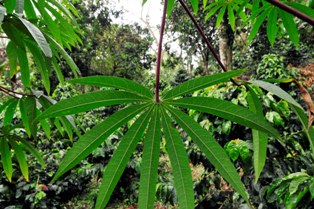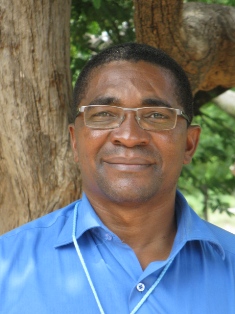New shoots of a green revolution in Africa: Disease-resistant cassava varieties put down roots in Tanzania
- Published Date
In mid-November 2011, the UN Food and Agriculture Organization (FAO) released a press statement expressing alarm at the spread of the cassava brown streak disease in the East Africa Region, saying it is on the verge of becoming an epidemic with grave implications for food security and livelihoods. The agency called for increased funding, research and surveillance to contain the disease.

Cassava leaves
Just weeks later, GCP is delighted to announce the official release of four cassava varieties, bred through marker-assisted selection (MAS), and extensive collaboration combining the knowhow of multi-institutional agricultural experts worldwide and funding from various agencies.
These varieties of Manihot esculenta have manifold benefits: dual resistance to cassava mosaic disease (CMD) and cassava brown streak disease (CBSD), and productivity potential of up to double the yield of existing commercial varieties.
Of the four varieties released, two are for the coastal belt while the other two are for the semi-arid agroecologies of Central Tanzania.
The variety release is a triumph of hard work over adversity as cassava is a scientifically complex crop to research and breed, and this tremendous collaborative effort brought together research institutes including the Agricultural Research Institute (ARI), Naliendele, Tanzania; the Nigerian National Root Crops Research Institute (NRCRI); the International Center for Tropical Agriculture (CIAT); the International Institute of Tropical Agriculture (IITA); the Donald Danforth Plant Science Center (DDPSC) in USA; and the CGIAR Generation Challenge Programme (GCP). Funding was also a collaborative effort, with support from The Rockefeller Foundation, GCP, Tanzania's Ministry of Agriculture and the Alliance for a Green Revolution in Africa (AGRA).
 |
| Geoffrey Mkamilo |
Members of the GCP-supported Cassava Breeders Community of Practice have heartily congratulated the Tanzania team for this release, expressing hope that this effort will soon be felt in the lives of "...the poor cassava farmers suffering from the ravages of CBSD," to quote Dr Heneriko Kulembeka of ARI who was part of the project technical team.
Dr Chiedozie Egesi and his colleagues at NRCRI have offered the Tanzania team the benefit of NRCRI's expertise to ensure quick delivery to farmers, drawing on experience gained following the December 2010 release in Nigeria of UMUCASS33, a disease-resistant high-yielding cassava variety, which, like the four new Tanzanian varieties, is also of joint African and South American parentage.
In a congratulatory message to Dr Mkamilo, GCP's Product Delivery Leader and Cassava Research Initiative (RI) facilitator, Dr Larry Butler, remarked: "Once again, a cassava team has demonstrated the efficacy of using marker-assisted selection to develop improved varieties. You and your team should be justifiably proud! The incorporation of CBSD resistance is particularly exciting!"
 |
| Peeled cassava |
For more information: please contact This email address is being protected from spambots. You need JavaScript enabled to view it. .
An orphan crop comes home: how the mighty, meaty pigeonpea genome was decoded
- Published Date
 31 Jan 2012
31 Jan 2012
A six-year, multi-institute collaborative project has successfully sequenced the pigeonpea genome. This result opens the floodgates for developing new varieties of the legume, which in turn will have a significant impact on the lives of people in resource-poor communities in the semi-arid regions.
The initiative was led by Rajeev K Varshney, GCP's Theme 1 Leader (Comparative and Applied Genomics), who, with others, elaborates on the many virtues and challenges of this courageous crop and the opportunities brought by access to its genome.
2011 GRM materials now online
- Published Date

For five days in September 2011, GCP researchers from around the globe joined forces on Indian soil for GCP's General Research Meeting held in Hyderabad, Andhra Pradesh. Materials from the event, including presentations, posters and photographs, are now available online.
The 2011 GCP General Research Meeting (GRM), which took place at the Hyderabad Marriott Hotel and Convention Centre from 21-25 September 2011, and hosted by ICRISAT, was a truly global meeting, with 160 participants from forty countries representing diverse institutes and specialisations. Principal Investigators from the majority of ongoing GCP projects attended and reported on project progress and updates from their fields of study.
In addition to the plenary sessions, covering general GCP activities, thematic areas and Research Initiatives, the meeting included parallel sessions focussing on nine specific crops (beans, cassava, chickpeas, cowpeas, groundnuts, maize, rice, sorghum and wheat). There was also a series of specialised informatics meetings, plus presentations and dynamic exhibitions of posters covering GCP projects and related work. An open morning and field trip, taking in the sights of Hyderabad, and a guided tour of ICRISAT and its work rounded off the programme in style.
Outcomes from the meeting, including presentations, posters and photographs, are now available online.
The GRM also got a spotlight on Indian media (thanks to ICRISAT), and was reported across local electronic media, radio and television, plus in the following printed media:
- Hindu Times
- ICRISAT's newsletter, Happenings
- Business Standard
GCP flaunts a nice turn of phrase with new tagline
- Published Date

Towards the end of last year, a small group at GCP knocked heads (and a few knuckles too!) and locked lexicons to come up with a new tagline that better reflects what and where GCP is today. From a long list of suggestions, the following winner was selected:
Partnerships in modern crop breeding for food security
This new slogan replaces Cultivating plant diversity for the resource-poor, which had been an apt description for GCP in its middle years.
This change in tagline will be reflected throughout GCP's online presence and future print publications.
For the curious, GCP's tagline in its early years was Tapping nature's diversity for humanity.
Plus two integrated into the IBP team
- Published Date

In the course of 2011, two more members became an integral part of the Integrated Breeding Platform (IBP) team.
Firstly we have Clarissa 'Candy' Pimentel, based at GCP Headquarters in Mexico, who is our Data Manager/Training Specialist. She has specific responsibility for the Central Crop databases accesible via the IBP Portal and associated tools. She is actively involved in both the development of the IB FieldBook and the training of data mangers and breeders in the use of both that and other data management tools of the IB CWS.
Secondly, Mark Sawkins has joined the team as IBP Configurable Workflow System Manager, and will oversee the design, testing and deployment of the CWS from a user perspective, ensuring that the system and the tools embedded in it (both standalone and web-based) meet the needs and expectations of the users and are easy to use. He is based in Toulouse, France.
And finally, there have been further changes in IBP management.


